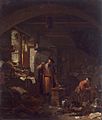The Alchemist Discovering Phosphorus facts for kids
Quick facts for kids The Alchemist Discovering Phosphorus |
|
|---|---|
 |
|
| Artist | Joseph Wright of Derby |
| Year | 1771 |
| Dimensions | 127 cm × 101.6 cm (50 in × 40.0 in) |
| Location | Derby Museum and Art Gallery, Derby |
The Alchemist Discovering Phosphorus is a famous painting by Joseph Wright of Derby. He finished it in 1771 and later worked on it again in 1795. The painting's full name is quite long: "The Alchymist, in Search of the Philosopher’s Stone, Discovers Phosphorus, and prays for the successful Conclusion of his operation, as was the custom of the Ancient Chymical Astrologers".
This artwork shows an alchemist in his workshop. He is trying to create the legendary Philosopher's Stone. People believed this stone could turn ordinary metals into gold. Instead, the alchemist accidentally discovers phosphorus, a glowing chemical element. This unexpected discovery surprises him greatly.
Contents
Understanding the Painting's Story
The painting tells a story that was popular in books about chemistry during Wright's time. Alchemists were like early scientists. They mixed different substances and performed experiments. They often combined their work with astrology and prayer. This was common for "chymical astrologers" back then.
The Alchemist's Discovery
In the painting, the alchemist is shown kneeling. He is looking at a glowing flask. This glow comes from the phosphorus he has just made. The light from the flask brightens the dark room. It also highlights the alchemist's face and the tools around him. This dramatic lighting is a special part of Joseph Wright's style.
What is Phosphorus?
Phosphorus is a chemical element. It glows in the dark when it reacts with air. This glowing property made it seem magical to people in the past. It was first discovered in 1669 by a German alchemist named Hennig Brand. He was also trying to find the Philosopher's Stone.
About the Artist: Joseph Wright of Derby
Joseph Wright of Derby was an English painter. He lived from 1734 to 1797. He is famous for his paintings that use strong light and shadow. Many of his artworks show scientific experiments or industrial scenes. He often painted people looking at new inventions or discoveries.
Wright's Artistic Style
Wright's use of light is called chiaroscuro. This technique creates a strong contrast between light and dark areas. It makes the main subject stand out. In The Alchemist, the glowing flask is the brightest part. It draws your eye right to the moment of discovery.
Journey of the Painting
After Wright finished the painting, he took it with him to Italy in 1773. He stayed there for two years, from 1773 to 1775. The painting then returned to England with him. He worked on it again in 1795, making some changes. The painting was finally sold four years after he passed away. Today, you can see it at the Derby Museum and Art Gallery.
Images for kids
See also
 In Spanish: El alquimista descubriendo el fósforo para niños
In Spanish: El alquimista descubriendo el fósforo para niños


